Roberto de' Rossi was an early humanist in Florence, [1] a follower of Coluccio Salutati and, as the first pupil of Manuel Chrysoloras, one of the first Florentines to read Greek. Roberto de' Rossi was a wealthy patrician who never married and avoided public office but devoted his life to books and his studies in his house and garden in the Oltr'Arno district of Florence. [2] His translations of Aristotle and other classical Greek writers made them widely available to the Latin-reading public, but his modern claim to fame is as the tutor of Cosimo de' Medici, a role for which he was selected by Giovanni di Bicci. Roberto's friends Leonardo Bruni and Niccolo Niccoli were inherited by Cosimo and formed part of his circle.

Lorenzo di Piero de' Medici, known as Lorenzo the Magnificent, was an Italian statesman, banker, de facto ruler of the Florentine Republic, and the most powerful and enthusiastic patron of Renaissance culture in Italy. He was a magnate, diplomat, politician and patron of scholars, artists, and poets. As a patron, he is best known for his sponsorship of artists such as Botticelli and Michelangelo. He held the balance of power within the Italic League, an alliance of states that stabilized political conditions on the Italian peninsula for decades, and his life coincided with the mature phase of the Italian Renaissance and the Golden Age of Florence. On the foreign policy front, Lorenzo manifested a clear plan to stem the territorial ambitions of Pope Sixtus IV, in the name of the balance of the Italian League of 1454. For these reasons, Lorenzo was the subject of the Pazzi conspiracy (1478), in which his brother Giuliano was assassinated. The Peace of Lodi of 1454 that he supported among the various Italian states collapsed with his death. He is buried in the Medici Chapel in Florence.
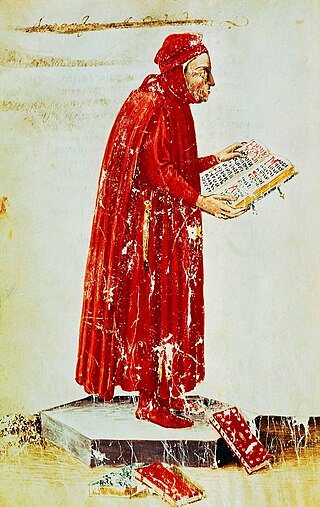
Coluccio Salutati was an Italian Renaissance humanist and notary, and one of the most important political and cultural leaders of Renaissance Florence; as chancellor of the Florentine Republic and its most prominent voice, he was effectively the permanent secretary of state in the generation before the rise of the powerful Medici family.

Leonardo Bruni or Leonardo Aretino was an Italian humanist, historian and statesman, often recognized as the most important humanist historian of the early Renaissance. He has been called the first modern historian. He was the earliest person to write using the three-period view of history: Antiquity, Middle Ages, and Modern. The dates Bruni used to define the periods are not exactly what modern historians use today, but he laid the conceptual groundwork for a tripartite division of history.

Guarino Veronese or Guarino da Verona was an Italian classical scholar, humanist, and translator of ancient Greek texts during the Renaissance. In the republics of Florence and Venice he studied under Manuel Chrysoloras, renowned professor of Greek and ambassador of the Byzantine emperor Manuel II Palaiologos, the first scholar to hold such course in medieval Italy.

ManuelChrysoloras was a Byzantine Greek classical scholar, humanist, philosopher, professor, and translator of ancient Greek texts during the Renaissance. Serving as the ambassador for the Byzantine emperor Manuel II Palaiologos in medieval Italy, he became a renowned teacher of Greek literature and history in the republics of Florence and Venice, and today he's widely regarded as a pioneer in the introduction of ancient Greek literature to Western Europe during the Late Middle Ages.
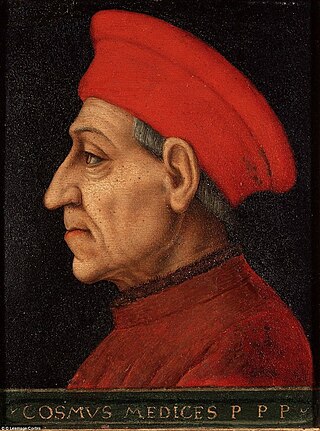
Cosimo di Giovanni de' Medici was an Italian banker and politician who established the Medici family as effective rulers of Florence during much of the Italian Renaissance. His power derived from his wealth as a banker, and inter-marriage with other powerful and rich families. He was a patron of arts, learning, and architecture. He spent over 600,000 gold florins on art and culture, including Donatello's David, the first freestanding nude male sculpture since antiquity.

The Republic of Florence, known officially as the Florentine Republic, was a medieval and early modern state that was centered on the Italian city of Florence in Tuscany, Italy. The republic originated in 1115, when the Florentine people rebelled against the Margraviate of Tuscany upon the death of Matilda of Tuscany, who controlled vast territories that included Florence. The Florentines formed a commune in her successors' place. The republic was ruled by a council known as the Signoria of Florence. The signoria was chosen by the gonfaloniere, who was elected every two months by Florentine guild members.

Benedetto Accolti was an Italian jurist, humanist and historian.

Michelozzo di Bartolomeo Michelozzi was an Italian architect and sculptor. Considered one of the great pioneers of architecture during the Renaissance, Michelozzo was a favored Medici architect who was extensively employed by Cosimo de' Medici. He was a pupil of Lorenzo Ghiberti in his early years, and later collaborated with Donatello.

Niccolò de' Niccoli was an Italian Renaissance humanist.

The Palazzo Vecchio is the town hall of Florence, Italy. It overlooks the Piazza della Signoria, which holds a copy of Michelangelo's David statue, and the gallery of statues in the adjacent Loggia dei Lanzi.
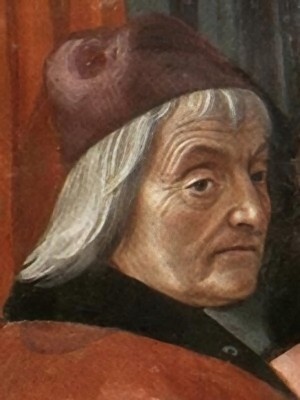
Cristoforo Landino was an Italian humanist and an important figure of the Florentine Renaissance.
John Argyropoulos was a lecturer, philosopher and humanist, one of the émigré Greek scholars who pioneered the revival of classical Greek learning in 15th century Italy.
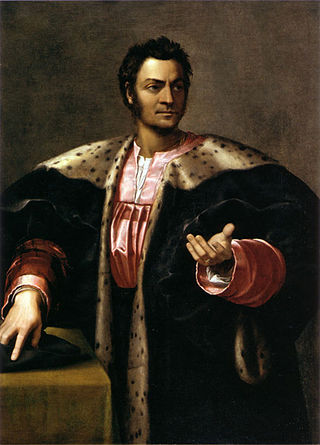
Rinaldo degli Albizzi (1370–1442) was an Italian nobleman, a member of the Florentine family of the Albizzi. Along with Palla Strozzi, he was the primary opponent of Cosimo de' Medici's rise in Florence.
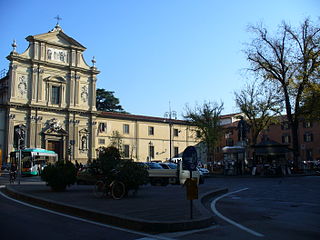
Museo Nazionale di San Marco is an art museum housed in the monumental section of the medieval Dominican convent of San Marco dedicated to St Mark, situated on the present-day Piazza San Marco, in Florence, a region of Tuscany, Italy.

Lorenzo the Elder was an Italian banker of the House of Medici of Florence, the younger brother of Cosimo de' Medici the Elder and progenitor of the so-called "Popolani" line of the family, named for a later generation whose members were supporters of the Florentine political activist Girolamo Savonarola.

Giacomo or Jacopo d'Angelo, better known by his Latin name Jacobus Angelus, was an Italian classical scholar, humanist, and translator of ancient Greek texts during the Renaissance. Named for the village of Scarperia in the Mugello in the Republic of Florence, he traveled to Venice where the Byzantine emperor Manuel II Palaiologos' ambassador Manuel Chrysoloras was teaching Greek, the first scholar to hold such course in medieval Italy.
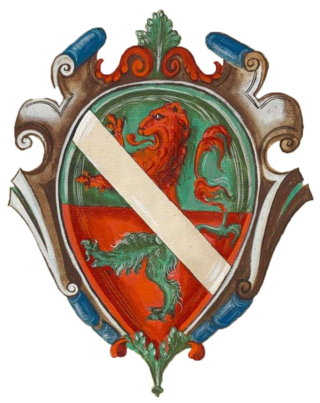
Giovanni di Bardo Corsi (1472–1547) was a politician and man-of-letters in Florence, Italy during the Italian Renaissance. He was a member of the committee that in 1512 restored the Medici to power in Florence after eighteen years of exile. He served as a diplomat to Charles V of Spain in 1515 and to Pope Paul III. In 1530, Corsi became Florentine gonfaloniere at the behest of Pope Clement VII, the Medici Pope.
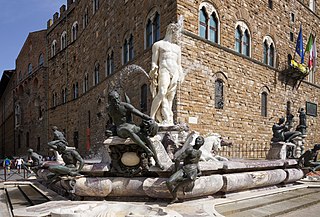
The Fountain of Neptune in Florence, Italy, is situated in the Piazza della Signoria, in front of the Palazzo Vecchio. The fountain was commissioned by Cosimo I de' Medici in 1559 to celebrate the marriage of Francesco de' Medici I to Grand Duchess Joanna of Austria. Cosimo I de' Medici was the Duke of Florence from 1537-1569 and responsible for a vast number of architectural and artistic elements in Florence that still exist today.
On Exile is a 1440 work of political philosophy by Francesco Filelfo. The overarching purpose of Filelfo's dialogue is to examine the problem of exile and assess how to cope with a demonized and defamed public image.